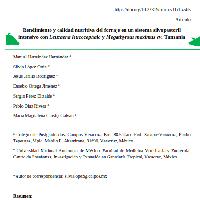Resumen
-
Se determinó el rendimiento y calidad del forraje en un sistema silvopastoril con Leucaena leucocephala cv. Cunningham (5,000 árboles ha-1) asociado con Megathyrsus maximus cv. Tanzania, en cuatro intervalos de descanso (20, 30, 40 y 50 días), en dos épocas (lluvias y seca) en clima cálido subhúmedo. Los tratamientos se distribuyeron aleatoriamente a las unidades experimentales (12 parcelas, 24 m2 c/u) y se evaluó el rendimiento y calidad nutritiva del forraje en la época húmeda (agosto-octubre, 2014) y seca (marzo-abril, 2015). La gramínea aportó la mayor proporción de forraje a la biomasa disponible (80 vs 20 %) y se produjo más biomasa total a 50 días en lluvias (5,300 kg MS ha-1) y seca (1,620 kg MS ha-1); en lluvias, la proteína cruda (PC) de los arboles aumentó gradualmente a 22 % (P<0.05) hasta 50 días, y en seca fue similar entre intervalos (28 %) (P>0.05); fibra detergente neutro (FDN) se mantuvo (44 %) (P>0.05) y fibra detergente ácido (FDA) aumentó (25 %) (P<0.05) a 50 días, mientras digestibilidad in vitro de la materia seca (DIVMS) disminuyó (49 %) (P<0.05). En la gramínea, la PC (10 %) (P<0.001) y DIVMS (58 %) se mantuvieron hasta 40 días y después declinaron (P<0.03), aunque FDN y FDA aumentaron significativamente a 50 días, en ambas épocas. la asociación L. leucocephala y M. maximus, alcanza su mayor producción entre 40-50 días, con mejor calidad nutritiva de la gramínea a 40 días, que se puede compensar con el valor nutritivo del follaje de los árboles hasta los 50 días de descanso, independientemente de la época.
-
The biomass and nutritional value of Leucaena leucocephala cv. Cunningham (5,000 trees ha-1) and Megathyrsus maximus cv. Tanzania was assessed in a silvopastoral system in a tropical hot sub-humid climate in the rainy and dry seasons. Samplings were done from August-October 2014 (rainy) and March-April 2015 (dry). The treatments were harvests at 20-, 30-, 40- and 50-d intervals in both seasons, randomly assigned to twelve (24 m2) paddocks. The grass accounted for most of the total available forage in the silvopastoral system (80 vs 20 %). In both seasons, the association yielded more forage at the 50-d interval (5,300 kg DM ha-1 in the rainy season and 1,620 kg DM ha-1 in the dry season) (P<0.05). During the rainy season, crude protein (CP) in the tree forage was higher at the 50-d interval (22 %; P<0.05), but did not change over the intervals during the dry season (28 %; P>0.05); neutral detergent fiber (NDF) did not change over time (44 %; P>0.05) and acid detergent fiber (ADF) increased in the 50-d interval (25 %, P<0.05) but in vitro dry matter digestibility (IVDMD) decreased (49 %; P<0.05), regardless of season. Crude protein (10%; P<0.001) and IVDMD (58 %; P<0.03) of M. maximus remained high from the 20- to 40-d intervals, although in both seasons NDF and ADF fractions significantly increased after the 40-d interval. The evaluated silvopastoral system attains highest yield between the 40- and 50-d intervals. The highest nutritional quality of M. maximus was at 40 ds, after which the nutritional quality of L. leucocephala may compensate for the lost nutritional quality of the grass, regardless of season.
